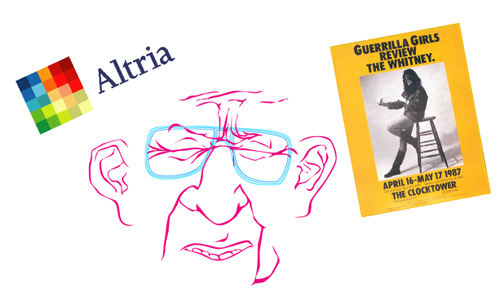The Whitney Biennial always draws fire from critics, but this year we're witnessing what seems like an unprecedented amount of actual anti-biennial action. Yesterday alone saw two broadsides against the event, including a fake press release satirizing the event's corporate sponsorship and a demand from the Arts and Labor group to make the 2012 Biennial the last. Today, ARTINFO's Julia Halperin broke news that Sotheby's locked-out art handlers will be using the occasion to try the auction house in the court of public opinion, protesting because of Sotheby's sponsorship of the biennial.

ARTINFO's brief and partial history of anti-Biennial activism
/ Courtesy the Wayback Machine, Whitney Biennial, and Copyright © 1987 by the Guerrilla Girls
Still, this is hardly the first time that artists have protested the Biennial -- in fact, it is one of the most frequently protested exhibitions in modern art history, second only perhaps to the salons of late-19th century Paris for its capacity to stir up anger towards art-world power structures. And of course, this makes sense: Since it claims to sum up the American art scene, what happens at the biennial really matters. Here, then, is a brief and partial history of anti-Biennial activism:
-- Guerrilla Girls, 1987: Perhaps the most serious example of using the biennial to put art-world inequity on trial involved the anonymous, gorilla-masked feminist artist-protesters known as the Guerrilla Girls, who gained national media attention with their exhibition "Guerrilla Girls Review the Whitney," held at the Clocktower in the spring of 1987. As part of the exhibition they released their "Banana Report," which documented the glaring under-representation of female and minority artists in Biennials between 1973 and 1987.
-- Miltos Manetas, 2002: Just in time for the 2002 Whitney Biennial, Greek-born Web artist Miltos Manetas took over the official-sounding URL WhitneyBiennial.com and created an incomprehensible Flash animation page, what he called a "parasite" exhibition dedicated to Internet works. He advertised it in advance by saying he was going to disrupt the actual opening by having two-dozen U-Haul trucks circle the block projecting Flash animation pieces by 200 excluded digital artists -- an emoty boast that proved to be little more than a publicity stunt for the satirical Web site, which still exists. (In a strange case of life-imitating-art, Manetas's online exhibition format seems to have informed the design of the Whitney's recently rebooted net art venture Artport.)
-- Anti-Smoking Prank, 2006: At the time of the 2006 Biennial -- the Chrissie Isles and Philippe Vergne-curated "Day For Night" (one of the few such events to have a title) -- crafty pranksters took over the Web site WhitneyBiennial.org, erecting something that looked fairly credible -- until you clicked on it. Then you got a message that said "Please learn about the Whitney Biennial's lead sponsor..." A further click took you to the logo of Altria, the tobacco company (once known as Phillip Morris) that was then the Whitney's chief corporate partner. A further click took you to a page by something called Altria Means Tobacco, an anti-smoking outfit. (The original fake site is no longer up, but can still be glimpsed via the Internet archive the Wayback Machine.)
-- Brucennial 2006-2010: The art collective known as the Bruce High Quality Foundation was invited to the big dance in 2010. But that didn't stop them from going ahead with their alternative version of the event, the so-called Brucennial. In truth, much like their alternative free art school, their anti-Biennial was less an attack on the art world as it was an attempt to clone it and add some more fun and slightly egalitarian modifications. Alongside the many, many little-known and younger artists included in the 2010 Brucennial -- selected by word of mouth -- were vetted art stars like David Salle, George Condo, and Julian Schnabel, adding clout and also drawing crowds.
-Benjamin Sutton, BLOUIN ARTINFO
More of Today's News from BLOUIN ARTINFO:
Like what you see? Sign up for BLOUIN ARTINFO's daily newsletter to get the latest on the market, emerging artists, auctions, galleries, museums, and more.